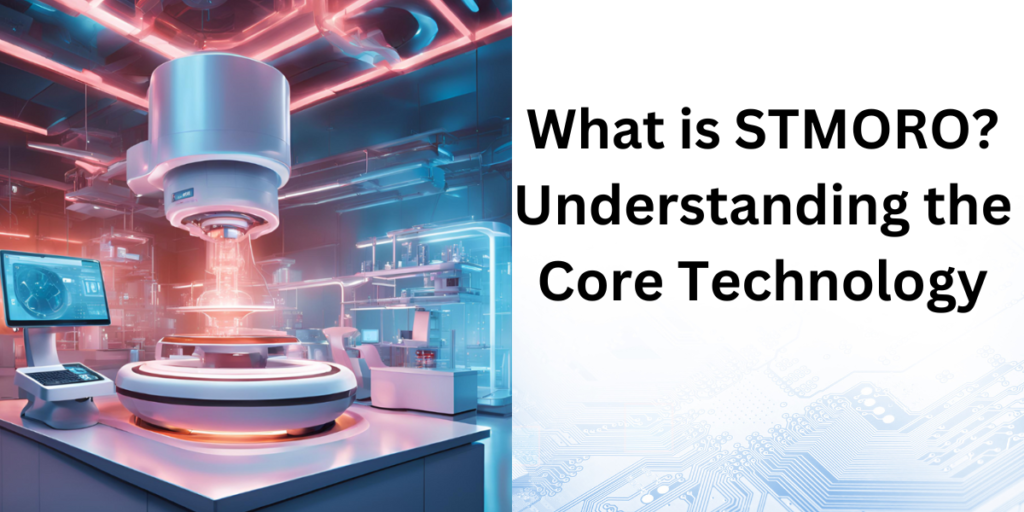STMORO: The Revolutionary Technology Changing Our World
In today’s digital age, STMORO is rapidly emerging as a game-changing technology with the potential to redefine various industries. Its innovative applications and groundbreaking capabilities are paving the way for new possibilities, transforming not only the way we work but also the way we interact with technology. In this article, we delve into the profound impact of STMORO, its core features, and how it is reshaping the modern technological landscape.
What is STMORO? Understanding the Core Technology

STMORO stands for “Systematic Technological Modulation and Optimization Resource Operations”, a cutting-edge framework designed to enhance computational efficiency and resource management. At its core, STMORO leverages advanced algorithms and AI-based models to optimize performance across a range of applications, from data processing to automation. It is built to integrate seamlessly with existing digital infrastructures, enabling companies to achieve higher productivity while reducing operational costs.
This technology is distinguished by its adaptability and scalability, making it suitable for industries as diverse as healthcare, finance, manufacturing, and entertainment. Its dynamic design allows it to be tailored to specific organizational needs, ensuring that businesses can stay competitive in a fast-paced market.
The Impact of STMORO on Modern Industries
1. Revolutionizing Data Processing and Analysis
Data has become the lifeblood of modern enterprises, and STMORO’s advanced data processing capabilities are crucial for businesses aiming to gain insights from their data. With its ability to process vast volumes of data in real-time, STMORO enables companies to make informed decisions quickly. This feature is especially beneficial in big data analytics, where the speed and accuracy of data interpretation can significantly impact business outcomes.
The system’s integration of machine learning (ML) and artificial intelligence (AI) allows for predictive analytics, helping organizations forecast market trends and customer behavior with unprecedented precision. This predictive power gives businesses a competitive edge, allowing them to anticipate changes and adjust their strategies accordingly.
2. Enhancing Automation and Workflow Efficiency
One of the standout features of STMORO is its role in automation. By automating repetitive tasks, STMORO not only reduces human error but also saves time and resources. It allows organizations to streamline workflows, enabling employees to focus on more strategic, creative tasks. In industries like manufacturing, where precision is critical, STMORO’s automation capabilities ensure that production lines run smoothly, minimizing downtime and increasing overall productivity.
Furthermore, STMORO supports robotic process automation (RPA), enabling businesses to automate complex processes that traditionally required manual intervention. This is particularly valuable in the financial sector, where tasks such as compliance checks, data validation, and transaction processing can be managed more effectively.
3. Transforming Cybersecurity with STMORO
In an era where cybersecurity threats are on the rise, STMORO plays a pivotal role in safeguarding digital assets. The technology’s advanced encryption methods and threat detection algorithms help protect sensitive information from breaches and cyberattacks. STMORO’s AI-powered security protocols enable it to identify potential vulnerabilities and neutralize them before they can be exploited.
This proactive approach to cybersecurity is vital for sectors such as banking and healthcare, where the protection of personal data is paramount. With STMORO, organizations can ensure compliance with stringent data protection regulations, safeguarding their reputation and maintaining customer trust.
The Key Benefits of Adopting STMORO Technology
1. Cost Efficiency and Resource Optimization
One of the primary advantages of STMORO is its ability to optimize resources. By improving the efficiency of existing systems, STMORO helps organizations reduce operational costs. It enables businesses to get more out of their hardware and software investments, extending the lifespan of digital infrastructure and minimizing the need for costly upgrades.
Additionally, STMORO’s scalability means that companies can scale their operations up or down without significant increases in costs. This flexibility is particularly useful for startups and SMEs, allowing them to grow sustainably without overextending their budgets.
2. Improving User Experience Through Personalization
STMORO is also making waves in the realm of customer experience. By leveraging AI-driven personalization, the technology can deliver tailored content and services based on user preferences and behavior. This is particularly valuable in e-commerce and digital marketing, where personalized recommendations can drive customer engagement and conversion rates.
By analyzing customer interactions and preferences, STMORO enables businesses to offer more relevant products and services, enhancing customer satisfaction and loyalty. This capability is transforming the way companies connect with their audience, leading to deeper, more meaningful relationships with customers.
3. Facilitating Innovation in Research and Development
STMORO’s ability to process complex datasets and automate routine tasks has made it a valuable asset in research and development (R&D). It allows researchers to analyze large datasets with greater speed and accuracy, accelerating the pace of innovation in fields like biotechnology, aerospace, and material science.
With STMORO, R&D teams can focus on exploring new ideas and solving intricate problems rather than getting bogged down in time-consuming data analysis. This results in faster time-to-market for new products and innovations, enabling companies to stay ahead in competitive markets.
Challenges and Considerations in Implementing STMORO
While the benefits of STMORO are significant, it is important to consider the challenges that come with its implementation. Organizations must ensure that their existing IT infrastructure is compatible with STMORO to fully leverage its capabilities. This may involve upgrading software, training staff, and reorganizing workflows to integrate the new technology seamlessly.
Moreover, data privacy remains a key concern, especially when implementing AI-driven systems like STMORO. It is crucial for businesses to adhere to regulatory frameworks and ensure that customer data is handled responsibly. Proper data management and encryption protocols must be in place to mitigate potential risks.
The Future of STMORO: What to Expect
The future of STMORO holds exciting possibilities. As AI and machine learning continue to evolve, STMORO is expected to become even more intelligent and adaptive, capable of handling more complex tasks with minimal human intervention. Future iterations of the technology may see deeper integration with Internet of Things (IoT) devices, enabling real-time data exchange across connected systems.
Furthermore, STMORO is likely to play a key role in the development of smart cities, where efficient resource management is critical for sustainability. By optimizing energy usage, traffic flow, and public services, STMORO could help create urban environments that are not only more efficient but also more livable.
Conclusion: Embracing STMORO for a Better Tomorrow
STMORO is undeniably a revolutionary technology that is changing the way we approach automation, data processing, and cybersecurity. Its ability to adapt, optimize, and enhance performance makes it a valuable tool for businesses across various industries. As we look to the future, STMORO’s potential to drive innovation and efficiency will continue to make it a cornerstone of technological advancement.
By adopting STMORO, organizations can position themselves for success in a rapidly changing digital landscape. As more businesses recognize the transformative power of this technology, STMORO is set to become a key driver of growth and competitive advantage in the years to come.



